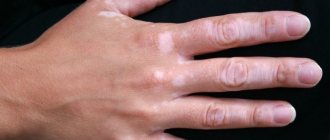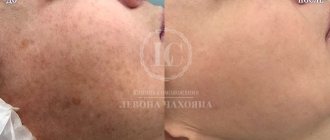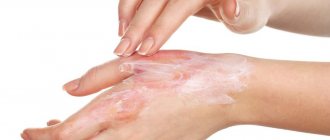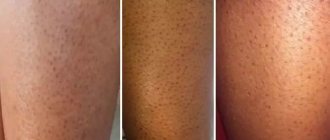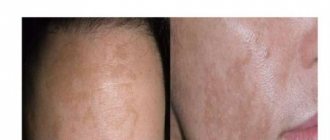Author
: Grachev Ilya Illarionovich
Editor
: Efremov Mikhail Mikhailovich
Date of publication: 09/24/2018 Date of update: 06/08/2020
Regular psoriatic plaques can be seen not only on the elbows. No less often they are located on the skin of the anterior (extensor) surface of the knee joint. In some patients they remain unchanged for years, while in others they spread to neighboring and distant parts of the body. There are other manifestations of psoriasis on the legs. When should they be treated and is it worth doing if the disease does not progress? The answer to this question will be given by the specialists of the Paramita clinic.
Why does psoriasis develop on the legs?
Psoriasis on the legs is a chronic skin pathology that has a hereditary predisposition. The development of the disease is facilitated by the influence of predisposing factors. Factors predisposing to the development of psoriasis on the legs:
- Limb injuries - abrasions, cracks, wounds. In people prone to this pathology, they often become inflamed, accompanied by itching, and scratching. Against this background, psoriatic rashes appear. These causes most often cause psoriasis in the knee joints in children, adolescents and athletes.
- Skin diseases and foot abrasions. The disease especially often develops against the background of fungal infections. It is important to wear tight shoes, in which the feet sweat and get injured.
- Metabolic disorders, obesity, diabetes mellitus, endocrine diseases, age-related hormonal imbalances, pregnancy. Any hormonal imbalance can cause the onset of the disease.
- Any chronic processes and foci of infection leading to intoxication of the body.
- High emotional, mental and physical stress.
- Improper, irregular diet, intestinal dysbiosis.
- Immunity disorders.
Psoriasis of any localization can spread throughout the body, so do not delay treatment.
See how easily the disease can be cured in 10-12 sessions.
Exposure to one or more predisposing factors causes a chain reaction in the body:
- metabolism is disrupted;
- biologically active substances are released that stimulate the rapid division of surface cells of the skin epithelium; the formation of scales and peeling begins;
- Antibodies to your own skin cells are formed in the blood, an autoimmune inflammatory process begins - characteristic papules appear.
Psoriasis on the legs can develop on different parts of the skin, but most often the rash appears on the knees and feet. It also looks different.
Varicose veins
Varicose veins are one of the most common causes of edema. Due to the weakening of the tone of the venous walls, the blood in the vessels stagnates, and the fluid pressure in the vessels increases. The body tries to regulate this situation on its own, and as a result, some of the fluid leaks into the tissue surrounding the vessel.
Varicose swelling usually worsens in the evening. To relieve the condition, you need to lie down and elevate your legs. You can also wear compression stockings (if you have one) or do some exercises to get your blood flowing. It is also useful to make contrast baths.
But if you notice a combination of redness of the skin on your legs and swelling, we recommend that you consult a doctor. This may be a manifestation of thrombophlebitis - a dangerous condition when the lumen of a vein is closed by a thrombus, a blood clot. As a result, blood flow through such a vessel stops.
Thrombophlebitis requires mandatory treatment from a specialist. If blood clots form in the lumens of the vein, it means that a floating thrombus may form in one of the vessels. It is able to move through the bloodstream, and can ultimately clog the pulmonary vessels.
So, if your legs are very red and swollen, or if the redness on your leg is accompanied by pain, rush to the doctor. After all, this may be the result of a minor injury, or it may indicate a somatic disease or the formation of blood clots. Only a specialist will determine the true cause of your condition and help normalize the situation. Treat yourself and your health carefully and feel light and comfortable!
Psoriasis on the knees
The manifestation of psoriatic rashes on the extensor surface of the knee joints is typical.
Psoriasis on the knees begins with the appearance of a small round or oval-shaped spot. The spot gradually turns into a papule with a raised, inflamed base. The early plaque is covered with silvery scales on top and is surrounded by a brighter corolla that rises above its surface and has no scales. If you scratch the papule, first the appearance of a stearin stain appears, and then a thin transparent film. Further exposure to the film is accompanied by the appearance of droplets of blood—blood dew—on its surface. In the initial stage of psoriasis of the legs (also called progressive), there may be one or two papules, then several more appear and they grow, merge with each other, forming large plaques of various configurations. The appearance of new rashes at the site of injury to the skin - scratches, abrasions, etc. is typical.
Psoriasis often stops at the initial stage and plaques in the knees, feet, and legs can be seen for several years and even decades. Such plaques are called duty plaques. With additional exposure to provoking factors, psoriasis can enter a progressive stage at any time, spreading from the legs to other parts of the body.
The next period is called stationary. The spread of the psoriatic rash stops and it looks the same all the time. After some time, the final regressive stage begins, when the rash gradually fades. The process can take place in two directions:
- from the center to the periphery - a pink corolla forms around the papule;
- from the periphery to the center - the corolla is white.
Gradually, white or brownish pigment spots form at the site of the rash. The process proceeds in waves: exacerbation is replaced by remission and vice versa.
Atypical type of psoriasis on the legs
Psoriatic rashes may have uncharacteristic localization and appearance. This form of psoriasis is localized not on the extensor side, but on the flexor side of the leg joints, in the area of skin folds. Since the skin in this area constantly sweats, the scales on the rash are not always noticeable in the initial stage. Papules in the initial stage of the disease may look like ordinary prickly heat and be accompanied by severe itching.
Subsequently, the process spreads to surrounding areas and acquires a characteristic appearance. The stationary and regressive stages proceed in the same way as in a typical disease.
"Cardiac" edema
With diseases of the cardiovascular system, in particular with heart failure, swelling also occurs, which in some cases may be accompanied by redness of the legs. In this case, swelling increases if it is hot outside, if a person spends a lot of time on his feet. But at rest the swelling subsides. The leg in the area of swelling is soft to the touch.
Interestingly, cardiac edema can go away on its own if the heart function improves at some point or the patient reduces the level of activity. However, their appearance indicates that you need to contact a cardiologist.
Plantar type of psoriasis
Psoriasis on the legs may first appear on the soles of the feet. In this case, the following may appear on the feet:
- typical rashes in the form of papules at the initial stage; over time, they merge with each other to form large plaques; this is a typical form, it proceeds in the same way as in other areas;
- the skin of the soles becomes covered with flaky itchy spots, it is dry, thickened (psoriatic calluses), and covered with cracks; this is the so-called horny form of the disease; cracks in the affected areas of the skin of the feet are very painful, which creates great problems when wearing shoes;
- pustular (purulent) rashes appear on the soles, merging into large lakes - this is Barber's pustular psoriasis; after the ulcers dry out, brown crusts form, at the site of which red spots remain; the toes may also be affected;
Allergy
Many allergic reactions, such as those caused by insect bites, involve redness and swelling of the skin. In case of allergies, the patient usually complains of redness and itching on the legs. With the onset of the warm season, you need to especially carefully monitor your condition: insects may be hiding in the grass. In case of a severe reaction, unpleasant symptoms can be relieved by taking an antihistamine. If you leave allergies unattended, getting rid of unpleasant symptoms will take a very long time.
Treatment methods for psoriasis on the legs
Treating psoriasis on the legs is a difficult task. Psoriasis should be treated comprehensively. It is recommended for patients with psoriasis on the legs:
- optimization of the daily routine, combining an active lifestyle with rest and healthy sleep at night;
- avoiding smoking and drinking any types of alcoholic beverages;
- eliminating stress;
- avoiding high physical activity with associated sweating;
- exclusion of contact (wrestling, boxing) sports;
- proper regular nutrition; Salty, sour, spicy foods, as well as vegetables containing essential oils that irritate the skin are not recommended; limited consumption of meat, consumption of large quantities of vegetables and fruits; drink plenty of fluids: drink plus 6 glasses per day added to the rest of the liquid;
- wearing shoes made of genuine leather or textiles with low heels that do not compress the feet;
- when playing sports, try not to injure the knee area;
- timely elimination of fungal, bacterial and viral infections of the feet;
- regular treatment under the supervision of a physician of all chronic pathologies, elimination of foci of infection;
- daily foot washing using hypoallergenic gels or baby soap; cutting toenails; after this, a moisturizing hypoallergenic cream should be applied to the skin;
- wearing socks made of cotton fabrics in light colors (dyes can provoke an exacerbation of psoriasis).
Red spots on the skin after stress
Diagnosis of skin diseases
Drug therapy
The choice of medications depends on the nature of psoriasis, the stage of the disease, its course and spread, the age of the patient, and the presence or absence of concomitant pathology. The goal of drug therapy is to eliminate the symptoms of the disease, which leads to an improvement in the patient’s quality of life. With the right approach to the treatment process, you can constantly maintain psoriasis in a state of remission, but you cannot guarantee its complete cure.
Preference is given to step-by-step external treatment with alternation of modern topical drugs belonging to different groups. For severe and widespread forms of psoriasis of the legs, individually selected combination treatment with general and local drugs is prescribed.
Local treatment
For local therapy the following are used:
- Ointments, creams, solutions based on glucocorticoid hormones (GCS). These remedies are widely used in the treatment of all forms of psoriasis of the legs. They perfectly relieve inflammation, swelling, itching, suppress proliferation (rapid division) of epithelial cells, inhibiting peeling. Combination ointments are also used, which, in addition to GCS, contain keratolytics - substances that dissolve keratinized epithelial cells and ensure rapid penetration of GCS to the cells (Diprosalik). But if the rash spreads quickly and aggressively, keratolytics can irritate the skin, so they are used with caution.
- Ointments, creams and lotions based on a synthetic analogue of vitamin D (Davonex). The drug actively affects the metabolism in cells, suppressing processes that contribute to the occurrence of disorders. Recently, a drug has been produced that, in addition to a synthetic analogue of vitamin D, includes an active substance from the GCS group (Daivobet). Modern step-by-step therapy includes the use of Daivonex first (in the early stages), and then Daivobet (during follow-up treatment).
- Keratolytic agents (salicylic acid) - soften rough layers of dead cells, improve access to cells of other drugs. Suitable for the treatment of horny psoriasis of the soles.
- Ointments and pastes based on activated zinc - have an anti-inflammatory and antiseptic effect, well suited for eliminating psoriasis of the feet and atypical forms.
- Ointments, creams, gels based on tar - have an anti-inflammatory, absorbable, antiseptic, analgesic effect. Suitable for eliminating the symptoms of plaque psoriasis on the feet in the stationary stage.
General treatment
General therapy is prescribed for a widespread process, as well as for the development of severe pustular forms of the disease, when local treatment is ineffective. Patients are prescribed:
- In order to eliminate intoxication and suppress allergies:
- calcium supplements, hemodez;
- antihistamines – Suprastin;
- In order to suppress the rapid proliferation (division) of cells in the lesions:
- drugs based on corticosteroids - administered in the form of infusions, injections or taken orally;
- cytostatics (Metoltrexate);
- aromatic retinoids (Acitretin).
- In order to suppress the excessive sensitivity of the immune system - immunosuppressants (Cyclosporin-A);
- In order to eliminate the symptoms of inflammation and tissue swelling, itching and pain:
- drugs based on corticosteroids;
- biological drugs (Remicade) - contain proteins that recognize and neutralize substances that support inflammation.
- In order to eliminate neuropsychic symptoms:
- sedatives (sedatives (Novopassit).
Effective methods for treating psoriasis on the legs
The following methods used in our clinic have been proven to be highly effective:
- PRP therapy - the essence of the method is that the patient is injected with his own blood enriched with platelets; Initially, blood is taken from a vein and injected pointwise into the affected areas of the skin of the legs; this leads to improved metabolic processes and suppression of the spread of psoriasis; helps well with all forms of disease;
- autohemotherapy - intramuscular injection of blood taken from the patient’s vein; has a general stimulating effect on the body;
- herbal medicine – the use of herbs and other medicinal plants. They are used as part of complex therapy to reduce the drug load on the patient’s body;
- acupuncture (acupuncture) is one of the methods of reflexology, the oldest method practiced by Chinese doctors; influence on special acupuncture points (AP) on the body and through them on various organs and tissues; specialists who are fluent in this technique can eliminate psoriatic rashes without the use of medications;
- vacuum therapy – exposure of the AT to rarefied air; for this purpose, special jars or devices are used;
- other methods of reflexology - cauterization with wormwood cigarettes, acupressure, auriculotherapy (impact on reflex points on the ear), etc.
How is leg psoriasis treated at Paramita Clinic?
A special feature of the Paramita clinic is the use of only effective methods of treating psoriasis on the legs at an affordable price. Both the most advanced European techniques and traditional oriental ones are used.
The correct choice and application of one or another method of therapy is possible only if the doctor has appropriate training and clinical experience. The clinic's doctors are fluent in all known methods of treating psoriasis, so it always takes place without side effects. All of them were trained in traditional healing methods in China and Tibet.
To avoid relapses, it is necessary to eliminate the cause of the disease.
Read more about our unique method of treating psoriasis
You can learn about the quality of treatment provided by Paramita specialists from reviews, as well as simply by asking visitors, because many of them are systematically treated at the clinic, maintaining a state of remission for years.
Doctor, what's wrong with me?
If your legs (or one leg) are swollen and red, we recommend consulting a doctor.
Especially if swelling occurs regularly. According to experts, swelling is not the norm. Even if you stand on your feet all day and are tired, the presence of recurring swelling still indicates certain problems. Do not self-medicate, especially if you notice redness and pain on your leg. This condition may be the result of an injury that you did not pay attention to at first. Or it may indicate the presence of a serious illness (including thrombophlebitis), for which it is necessary to receive professional medical help as quickly as possible. There may be several reasons for swelling and redness of the leg.
